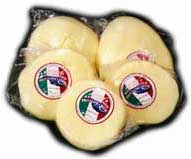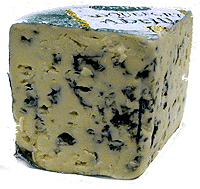 Cheddar Cheese Cheddar Cheese
|  Provolone Cheese Provolone Cheese |
SEMIHARD CHEESE
 Blue Cheese Blue Cheese
|  Roquefort Cheese Roquefort Cheese |
SOFT CHEESE
 Brie Cheese
Brie Cheese
CHEESE PROCESSING |
Most but not all cheeses result from a lactic fermentation
of milk. In general, the process of manufacture consist of two important steps:
Although most ripened cheeses are the product of metabolic activities of the lactic acids bacteria, several well-known cheeses owe their particular character to other related organisms.
| Swiss Cheese | A mixed culture of L.delbrueckii subsp. bulgaricus and S.themophilus is usually employed along with a culture of Propionibacterium shemanii, which is added to funtion during the ripening process in flavor development and eye formation. |
| Blue Cheese | The curds is inoculated with pores of Penicillium roqueforti which effect ripening and impart the blue-veined appearance characteristics of this type of cheese. Example: Roquefort Cheese |
There are over 400 varieties of cheeses representing fewer than 20 distinct types, and these are grouped or classified according to texture or moisture content. The three classes of cheese are hard, semihard, and soft.
HARD CHEESE
 Cheddar Cheese Cheddar Cheese
|  Provolone Cheese Provolone Cheese |
SEMIHARD CHEESE
 Blue Cheese Blue Cheese
|  Roquefort Cheese Roquefort Cheese |
SOFT CHEESE
 Brie Cheese
Brie Cheese